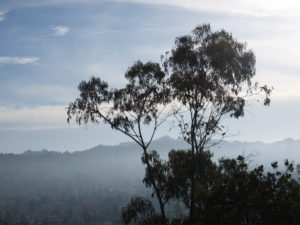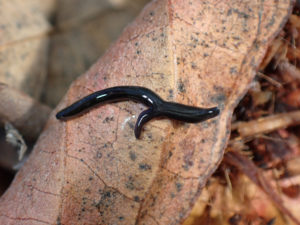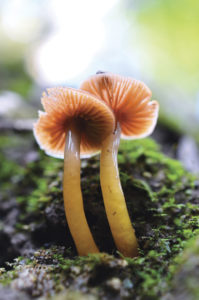Long, long ago, in a time before time, the place where we now live was a deep sea. Beneath the waters, however, the earth stirred. A coast range was lifted up. Rains fell upon the bare slopes. Rivers and streams formed, wearing away rock, transporting sediment.
At a very stately pace, over the last two million years, land and water have assumed the outlines we see today. In just a few centuries, some of the same forces that gave form to the land have also given substance to the soil.
From Rock to Soil
Soil begins with bare rock. Through the action of wind and rain and changing temperature, tiny particles wear off and gather, forming a loose matrix. This physical disintegration, combined with chemical decomposition, is known as weathering, and in it lies the beginnings of a soil.
The physical effects of weathering are easy to recognize. The pocketed sandstones along the San Mateo coast provide just one example of the scouring power of wind and water. With our mild Bay Area temperatures, examples of the changes wrought by the successive heating and cooling of stone aren’t as easy to find. Over the course of time, however, these differentials eventually weaken and fracture stone, peeling, chipping, and cracking it, liberating particles to become soil.
You can also see the effects of chemical weathering—some soils are red because the iron in them has oxidized, for example—but understanding the processes at work requires some abstraction. Hydration, hydrolysis, and dissolution are common chemical processes that result in the breaking down or putting together of elemental components of soil.
While the forces of wind and water are at work, and while chemical interactions are taking place, plants and animals make their various ways in the world—and help create soil in the process. Plant roots and leaves add organic material and a host of organisms move in, each having an impact on the quality and composition of the developing soil. Over the course of centuries, a body of soil grows, eventually reaching depths of several inches to, in some cases, many feet.
Soils in Profile
Any given soil consists of distinct layers, or horizons. The organic material at the soil surface is known as the O horizon. Underneath it, in descending order, are the A, B, and C horizons. The color and composition of these layers differs sufficiently that soil scientists use them to identify different soils—hundreds of thousands of unique groupings of soils have been named around the globe.
In the parlance of the farmer and the gardener, the O and A horizons are topsoil. This is where the bulk of biological activity takes place, and it is, roughly, the depth to which soil is tilled. When talking about soils from a gardener’s point of view, one is almost invariably talking about these uppermost layers of soil. And within that thin band of topsoil, gardeners and scientists move into a realm where definition can be had in two millimeters or less.
Soils in Particular
Soils are characterized predominantly by their textures—they are known, that is, by the combination of mineral particles, called sand, silt, and clay, that they contain. (All rocks, and hence the solid portion of soil, are made of minerals, which are either single elements or compounds of elements found on the periodic table.)
Sand, which is typically mineral quartz, can be from two to .05 millimeters in size. At two millimeters it is still smaller than the head of a pin, but that’s as big as soil-sized mineral particles get. Silt is next, in the .05 to .002 mm. range. Anything smaller than that is clay—its particles are so small that they can’t be seen without the assistance of an electron microscope.
Though most soil particles can’t easily be seen with the naked eye, they can be felt—between the fingertips and in the lower back. Shovel soil all day and you’ll know how heavy it is, especially when wet. Squeeze fine-textured, or clayey, soils between your fingers, and they feel sticky and slippery. You can shape them. Coarse-textured or sandy soils, on the other hand, are loose and porous and feel gritty to the touch. You can see sand particles with the naked eye. Silt, in-between both in terms of feel and appearance, is smooth and buttery on the fingertips.
The grittiness of sand and the stickiness of clay tell us a great deal about their properties as soils. The various amounts of sand, silt, and clay a soil contains influence how much water it can hold, how easily it releases nutrients, and how much air it contains.
Bay Area Soil Types
Though many varieties of soil can be found in the Bay Area, the majority of them are medium- to fine-textured soils that have formed in place directly from the rocks beneath them. Such soils are called residual. They are distinguished from depositional soils, which have been transported by gravity, wind, rain, or rivers to the place they’re found today.
Most of our residual, fine-textured soils formed from sedimentary rock that was once, eons ago, a depositional soil itself, before time and pressure turned it into rock. In many cases this rock has weathered to clay minerals and clayey soils that are nutrient rich, slow to absorb water, and slow to release it.
A few of the Bay Area’s clayey soils are depositional. They occur in basin lands such as our bayshore wetlands, where very fine, clay-sized sediments, transported by streams that drain into the Bay, finally settle out, forming a heavy clay soil over time.
At the opposite end of the spectrum are the large-particle sandy soils. They are usually depositional, left along creek banks and beds by streams whose flow is slowing, or carried by wind, forming dunes in pockets along the coast. Onshore winds blowing across beaches outside the Golden Gate account for the sandy soils in western and central San Francisco, which, underneath the veneer of urban development, is essentially a great dune complex.
Loamy soils, which are the optimum blend of sand, silt, and clay, can be found in alluvial or depositional valleys and bay fronts around the Bay. The Santa Clara Valley, well known for its agricultural productivity in the first half of the 20th century, is a floodplain soil that has nutrient-holding clays and also the good drainage of silt and sand. These fertile loams extend up through Fremont, Hayward, and San Leandro into parts of Oakland, Berkeley, and Richmond. They also occur along the Bay on the Peninsula, in the Tri-Valley area of Alameda County, and in eastern Contra Costa.
Along the coast from Half Moon Bay to Monterey Bay is a thin strip of fertile loam that has been likened to the rich prairie soils of the Midwest. Like the heartland prairies, our coastal terrace prairie is high in organic matter—decomposing leaves, stems, roots, snail shells, earwig carcasses, and so on. Soils found along the California coast have about 4 percent organic material, while inland soils have 1 to 2 percent. In general, the mineral fraction of soil—the particles—usually accounts for about 45 percent of the total volume of a soil and organic matter for about 5 percent. The remaining 50 percent is pore space, or the openings between soil particles. Those pores are filled with varying amounts of air and water, depending upon precipitation, drainage, evaporation, and transpiration by plants.
In parts of the Delta, there are soils that consist almost entirely of organic matter. Similar to the peat one can buy at nurseries, this deep soil was formed from the slow breakdown of tule reeds, cattails, and other wetland vegetation. Scientists classify them as muck, but, despite the name, these soils have been farmed for decades. The decomposed vegetation that makes up Delta muck is high in carbon, which, when exposed to the air, reacts with oxygen and breaks down, losing volume and gradually subsiding. Today, much of the Delta’s farmland is below sea level and remains arable only because of the levees that surround it.
Soil Biota
The decomposition of organic matter, which is essential to the formation of soil, is brought about through chemical reactions such as that of oxygen and carbon, but it is more often facilitated by living organisms. Soil is inhabited by a huge number of creatures, each of which contributes to a soil’s character and overall health.
Soil organisms range from single-celled animals such as bacteria and fungi to soft, sinuous worms and hard-bodied insects. The creatures we see stalking the soil’s surface, such as sow bugs and beetles, are the macrofauna; the smaller folk are truly small, but their impact is mighty. A single pinch of healthy soil harbors more than 10 million bacteria, for example, and they are just one of the many types of microorganisms that, in the course of living and dying, move materials, capture and recycle nutrients, transfer energy, and give the soil structure and integrity.
Different organisms play different roles. One of the functional roles of soil bacteria is that of decomposer: Bacteria consume organic matter, breaking it down into forms that can be used by other soil organisms. The protozoa—a group of larger single-celled animals that includes the well-known amoeba—are grazers. They feast on bacteria and release to the soil some of the nutrients captured by the decomposers.
Soil organisms also interact in ways that go beyond the etiquette of eat and be eaten. Some organisms depend upon one another or have an association that is beneficial to both. The rhizobium bacteria and mycorrhizal fungi provide examples of these mutualist relationships.
Like several other bacteria, rhizobium are capable of collecting, or fixing, nitrogen from the air and incorporating it into their bodies. When these bacteria die, the nitrogen they have captured remains in the soil, eventually becoming available for uptake by plant roots. The rhizobia go a step further, though, by taking up residence under the surface of pea-family plant roots and passing their nitrogen directly to these plants. Nitrogen is an essential nutrient for plants, but the mineral fraction of soil contains none. So, while there may now be nitrogen in any given soil thanks to organic matter, that nitrogen, initially, had to be plucked from thin air. Nitrogen-fixing bacteria, it could be argued, are responsible for life as we know it.
Of equal importance to the life of the majority of plants (and thus most animals) is an association of plant and fungi called mycorrhizae (the word means “fungus root”). Like the rhizobium bacteria, certain fungi can move into a plant’s roots, in this case either by forming a sheath around the roots or by growing directly into and through them. In this mutually beneficial arrangement, the fungi obtain sugars from the plant, while the plant gets an extension of its roots and root surface area. Mycorrhizal fungi substantially increase a plant’s ability to take nutrients and water from the soil.
A Structure for Life
Other fungi, chiefly the decomposers, play a very important role in building and maintaining the structure of the soil. Fungi bind soil particles, forming units called aggregates. In a soil with good structure, these joined particles are like the stones in a wall—but without mortar. Good soil structure also includes adequate pore spaces. Ideally, soil aggregates form an irregular framework through which air and water can flow easily and in which plant roots can move freely.
The ideal is not always reality, however. Texture does influence structure. Super-small, chemically active clay particles, for example, can stack up and stick together, creating a massed structure and tiny pore spaces that allow little passage of air, water, or plant roots. A loose, sandy soil, on the other hand, has large particles, loads of pore spaces, and almost no structure at all. As a result, water and nutrients pass right through. The soil dries out quickly. Plants not adapted to such conditions soon wilt and die.
That’s why soil biota are so important. Fungi and bacteria bind particles together, create open spaces, and generate humus, which also improves soil structure. Humus (pronounced like human) is a more-or-less stable form of digested organic material that can remain in the soil for centuries. It can loosen up a clay soil or hold together a sandy one. To return to the image of the stone wall, humus is the mortar—acting as a gelatinous lattice, one that helps soil particles cohere but also makes space between them.
A Body Alive
From bare outcroppings, soil begins as fallen bits and pieces of rock. Through the interactions of physical and chemical processes, and through the ceaseless activity of microorganisms, invertebrates, and insects, these random particles are augmented and ordered into a coherent body that influences and is responsive to its surroundings.
Soil acts, in the words of one expert, “as our earth’s primary cleansing and recycling medium.” We have seen how soil biota return nutrients to the soil; some soil bacteria and fungi also break down pesticides and pollutants. Soil’s detox capabilities have also been put to service in the field of medicine—penicillin was first derived from a soil bacterium, and dozens of subsequent antibiotics have also come from a single soil-dwelling genus, Streptomyces.
Soil is also inseparably linked to water supply and water quality. The amount of water in our aquifers, rivers, and lakes depends partly on the health of the soil. A topsoil that has good structure and is covered by vegetation will absorb almost all the water that falls upon it. Once absorbed, the entire soil body acts like a sponge, first holding large volumes of water, then slowly releasing it to aquifers and surface water bodies. The living soil also cleanses the water passing through it, filtering out particulate matter and absorbing pollutants.
Life Above Ground
Besides the tiny creatures who live at or near the surface of the soil, there are many larger animals—the moles and gophers who live underground and the deer, rabbits, birds, and other vertebrates—that burrow into it, scratch it with their hooves and talons, graze its vegetation, and leave their droppings on it. These activities enhance nutrient cycling, soil structure, water infiltration, and aeration.
There is one above-ground vertebrate, in particular, that has multiple impacts on the life of the soil. Human beings have cleared the ground, built upon it, farmed it, grazed it, and gardened it. In some cases our influence has been positive or benign; in many cases it has led to degradation. As a result of human activities, topsoils are blown or washed off our agricultural fields and often end up as a pollutant in our streams. In residential settings, our lack of understanding sometimes leads to over-irrigation and overuse of synthetic fertilizers. Most urban land uses deplete the soil of organic matter.
For gardeners and watershed residents, retaining organic matter and protecting soil biota is of primary concern. Though it is the least part of the soil, the organic component has the greatest importance. The health of soil biota is negatively influenced by common gardening practices such as removing plant debris and using quick-release fertilizers. Insecticides and herbicides, too, not only exterminate the pest, but kill beneficial soil organisms. Gardening organically and returning organic material to the soil both protect biota and restore soil fertility.
The Latin root for soil—solum—means seat. Every soil is in itself a habitat and provides the foundation for nearly every kind of plant. These plants, in turn, form the basis for countless food webs and natural relationships that sustain the majority of organisms on earth. The ground beneath our feet is in many ways the seat of life.
So, the next time you’re sitting trailside on a log or wandering through your yard, listen for the hum above and below. You can almost hear the invisible industry of sow bugs, earthworms, fungi, and bacteria at work. You can almost hear the plants grow. With a little care and exploration, you can add your own voice to the chorus.

.jpg)



